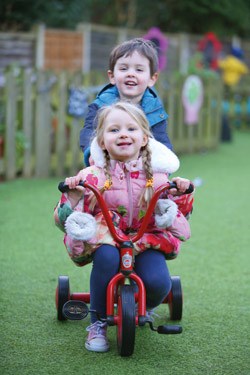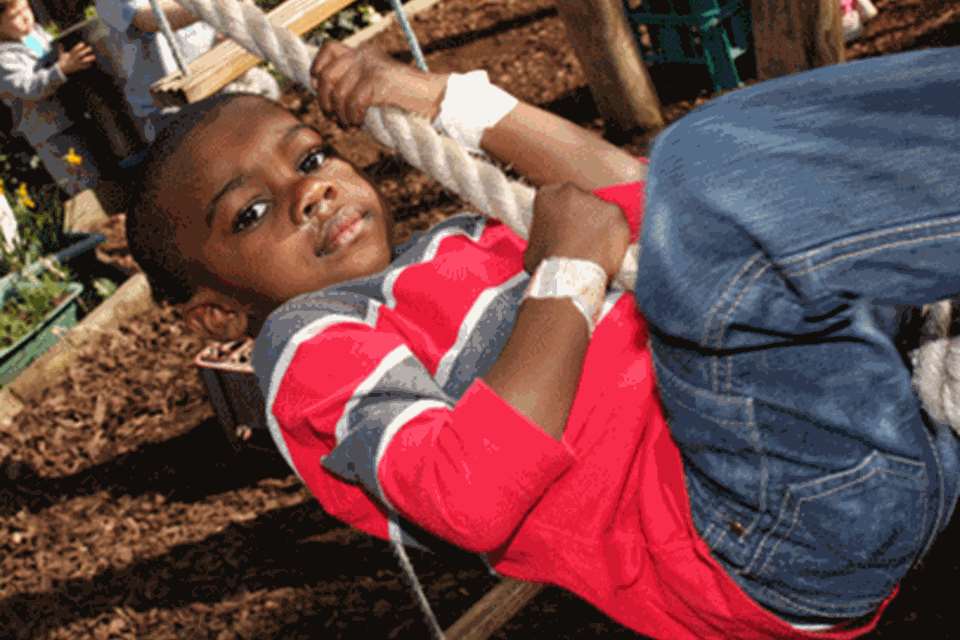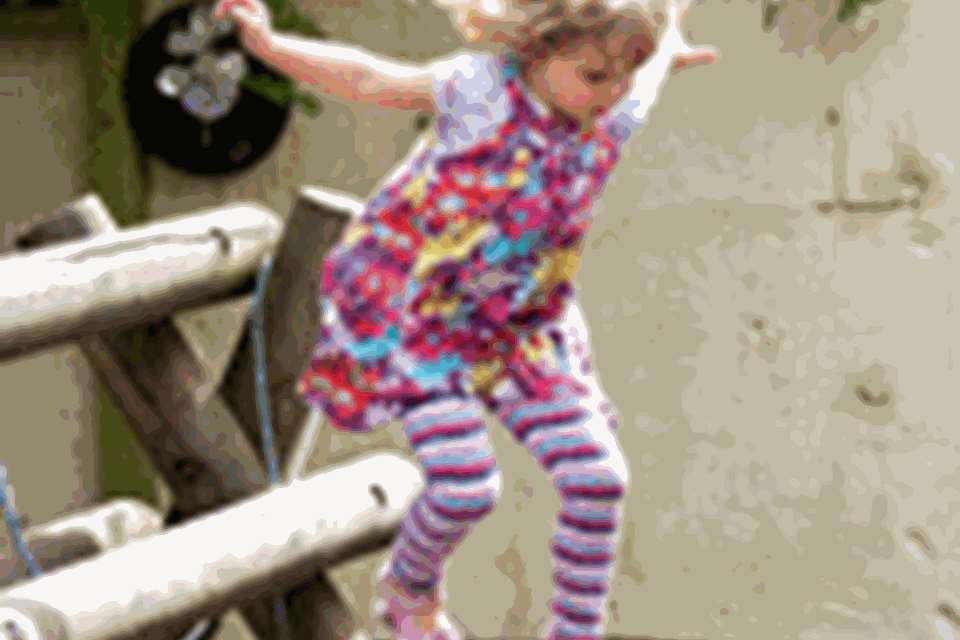Learning & Development: Movement - Body language
Anne O'Connor
Monday, May 30, 2016
Anne O’Connor explores the link between movement and well-being

One of the first special moments of connection for a pregnant woman with her baby is the experience of the moving foetus within the womb. Although those kicks and nudges may get increasingly uncomfortable for the mother, they are vital to the baby’s physical development and are an important sign of its continued well-being before birth (see www.kickscount.org.uk). They also provide the expectant mother (and others) with an important way of connecting with the baby, and this early ‘communication’ can help start the bonding process (O’Connor and Daly 2016).
Once a child is born, we continue to see the baby communicate through movement – for example, turning the face towards or away from something, kicking with the legs and reaching out with the hands. But a baby’s wriggles and kicks are also crucially important for the physical development of their skeletal structure, muscles and joints, and nerve and brain network.
Right from the very start, movement is helping to ‘wire up’ the baby’s brain to all parts of the body, making connections that build the central nervous system and shape the architecture of the brain. Babies are born with a biological drive to move because they innately know that movement is good for them.
Writing in Exploring Well-Being in the Early Years (ed Julia Manning Morton 2014), Mickey LeVoguer and Jasmine Pasch comment that, ‘Babies and young children, therefore, need plenty of opportunity for unrestricted movement to make those vital connections, and enough space to move around in so that they can practise over and over again, strengthening the connections as they move, play and actively explore the world around them.’
EARLY STAGES OF MOVEMENT
In their earliest months, a typically developing child will ideally spend lots of time lying on their backs so they can kick and stretch and wriggle, all of which will naturally lead to them rolling over by themselves ready for the next important stages of creeping and crawling. Spending short bursts of supervised time on their tummies is also important for a whole range of reasons linked to their well-being and development. These include strengthening of the neck muscles, opening of the chest and lungs to aid breathing, and assisting in the development of vision and continence.
Opportunities for creeping and crawling promote a whole host of important aspects of physical and neural development that can make a big difference to well-being, both in the long and short term.
Crucially, they also begin to provide the child for the first time with a sense of independence and autonomy as they can increasingly put will into action. They see something on the other side of the room; they now have the possibility of going and getting it, and they can follow a parent around rather than just calling or crying for their attention. And once they start to pull themselves up and cruise round the furniture, it is generally not long before they are ready to take those first few brave steps on their own.
THE MOTIVATION TO MOVE
The creeping and crawling stages are so full of developmental processes that it is really important we make sure children get lots of opportunities to continue to play and move (on their tummies, hands and knees and all fours) long after they are comfortably running around. This is especially true for babies who might have been early walkers or who didn’t crawl on all fours.
Although crawling and toddling babies still need to be supervised, restricting their movements by keeping them for lengthy amounts of time in ‘containers’ (for example, bouncy chairs, buggies and car seats) is not only likely to damage their rates of motor skill development, but can also affect their natural motivation and that all-important ‘biological drive’ to move. This continues to be true as children grow older, confined as they often are behind school tables with increasingly limited periods of active play.
There is increasing concern globally that a tendency towards a sedentary lifestyle, which is considered one of the possible contributory factors in the rise of obesity, may even be evident in very young children. For example, the Finnish national programme for physical activity in the early years comments that, ‘Three years of age marks the most crucial phase in terms of establishing a physically active or sedentary lifestyle. The patterns of behaviour and living that are established up until the age of three will stay with us into adulthood’ (Karvinnen et al 2015). It also acknowledges the responsibility that childcare practitioners hold in helping to promote positive attitudes to physical activity when so many children are now cared for outside of the home from a young age.

FEELING GOOD
Linked with this is our understanding that movement and physical activity can reduce stress and make us feel good, regardless of whether or not our levels of activity actually impact our weight. Studies in adults and older children have shown that physical activity can reduce symptoms of depression, lessen anxiety, and improve mood and emotional well-being, while physical inactivity can actually increase the risk of developing depression (Burdette and Whitaker 2005). These authors also cite research to suggest that gross motor play may be an important mechanism to dampen the ‘allostatic load’ caused by everyday stresses of a child’s life and which can affect their general health (McEwen 1998).
They point out, however, that scheduled, adult-led physical activity sessions (although useful and better than nothing) may not be as beneficial to the child as the spontaneous movement activity they engage in when playing.
‘A smile on the face of a playing child reflects multiple physiologic processes in the body that can improve health’ (Burdette and Whitaker 2005). They go on to suggest that adults who engage with children’s gross motor play also benefit from the movement and physical effort involved. This is a fact of which most early years practitioners are well aware, but is a point worth stressing to health professionals and others involved in trying to raise the activity levels of the general public – playing with your children helps keep you fit and can make you feel good. But we all know that being told to do something to improve our health doesn’t always make us want to do it and often has the opposite effect, which is why it is the ‘feel-good’ factor that is most significant here.
Improved mood is usually the most immediate and visible aspect of play –and is also the benefit that is most likely to reinforce the urge to play. The more parents enjoy playing with their children, the more they are likely to engage in it. And the more children enjoy physically active play in their early years, the more likely they are to retain positive attitudes to physical activity in later life – so will be predisposed to want to be physically active with their own children. As a result of these findings, Burdette and Whitaker propose a focus on the value of physically active play as a highly effective way of tackling concerns about childhood obesity, one of several factors currently affecting child well-being.
GRAVITATIONAL SECURITY
Play is a multi-sensory experience, and gross motor play engages two senses that are particularly important for our well-being – proprioception (the unconscious perception of movement and spatial orientation) and the vestibular system, which is the sensory mechanism in the inner ear that detects movement and helps keep us balanced (O’Connor and Daly 2016).
Sally Goddard Blythe’s book The Well-balanced Child (2005) highlights the importance of ‘balance’ to our physical and emotional well-being. Not only do we not want our children to fall over all the time, but we also want them to be emotionally ‘stable’ and ‘level-headed’ rather than ‘unbalanced’ and ‘wobbly’. Emotional behaviours are generated in the brain by the limbic system, and this relies on the vestibular system to help modulate input from all our senses.
Also connected to our vestibular development are feelings of ‘gravitational security’, which are powerfully linked to our sense of self and well-being, helping us to feel firmly rooted on the ground and knowing which way is up. A Jean Ayres, one of the pioneers of sensory integration work, suggested that, ‘Gravitational security is so vital to emotional health that nature has given us a strong inner drive to explore gravity and master it’ (Sensory Integration and the Child 2005). This is exactly what young children are doing in their earliest movements towards being upright and mobile, when they develop as much expertise in falling as anything else. Ayres even suggests that all other relationships may not develop well if the child’s relationship to the earth is insecure, leaving them ‘lost in space’.
ROCKING AND ROLLING
One of the most instinctive ways in which we soothe babies or young children when they are distressed is to rock them gently. ‘Knowing more about the vestibular system helps us to see why we do this – the gentle motion simultaneously soothes and strengthens the vestibular system and if it is accompanied with loving, affectionate words and touch, it reinforces attachments and feelings of emotional, as well as gravitational, security’ (O’Connor and Daly 2016).
Similarly, many of the gross motor activities that children love to engage in also stimulate and strengthen the vestibular system. Spinning, sliding and rolling around on the floor are the kinds of activities that children often choose to do spontaneously over and over again. It is worth remembering when it starts to get on our nerves and we try to stop them that they are actually engaging in intense body and brain development that potentially has long-term implications for both their health and well-being.
SITTING STILL
Increasingly in the early years sector, we are faced with Government demands for us to address childhood obesity while the same Government promotes a narrow curriculum with less and less time for gross motor activity. But it is also true that while on the one hand we have real concerns about children becoming obese because they are not moving enough, we also worry that more and more children seem to be ‘hyperactive’ and don’t know how to be still. However, an increasing understanding of children’s neurophysiological development would suggest that these two factors may be linked.
As Goddard Blythe and others have pointed out, it seems that being able to be still is the most advanced form of movement, and you need to do a whole lot of moving before the vestibular system (in particular) is fully developed enough to enable the body control that is required to hold the body still (Goddard Blythe 2005).
If we increasingly lower the age at which we expect children to sit still – and make them do it for longer and longer periods of time, then, ironically, we are ultimately not allowing them to fully develop the art of being still. Young children learn best through an embodied education, rich with physically active, first-hand experiences, but we also want them to benefit from the physical and mental composure that stillness affords. Denying children the opportunity to gain core strength, balance and body control through movement and activity can impact their well-being in so many ways, not least of which is a possible reduction in their ability to concentrate and learn.
Since the early days of the British Nursery School, with its emphasis on the importance of outdoor physical activity for children’s health and well-being, there has never been a more crucial time for advocating loudly and clearly for the need for babies and young children (up to the age of eight) to have daily, sustained periods of activity, indoors and out, that is both physical and playful. Their well-being depends upon it, both now and for their future as the healthy, well-balanced adults we need them to become.
MORE INFORMATION
O’Connor, A and Daly, A (2016)Understanding Physical Development in the Early Years (Routledge)
LeVoguer, M and Pasch, J (2014) ‘Physical Well-being: Autonomy, exploration and risk-taking’ in Manning-Morton, J (ed)Exploring Well-being in the Early Years (OUP)
Karvinen, Jet al(2015)A new physical activity and well-beingprogramme for early childhood education, http://bit.ly/1XpT90N
Burdette, HL and Whitaker, R (2005) ‘Resurrecting Free Play in Young Children’, Archives of Pediatrics and Adolescent Medicine, 159(1), 46-50
McEwen, BS(1998) ‘Protective and damaging effects of stress mediators’, New England Journal of Medicine, 338, 171-179
Greenland, P (2000)Hopping Home Backwards – Body Intelligence and Movement Play. Jabadao
Connell, G and McCarthy, C (2014)A Moving Child is a Learning Child. Free Spirit Publishing
White, J (2015)Every Child a Mover. Early Education
Anne O’Connor is co-founder and principal consultant of training company Primed for Life (www.primedforlife.co.uk). Her latest book, Understanding Physical Development in the Early Years: Linking Bodies and Minds, co-written with Anna Daley and published by Routledge, is out now










